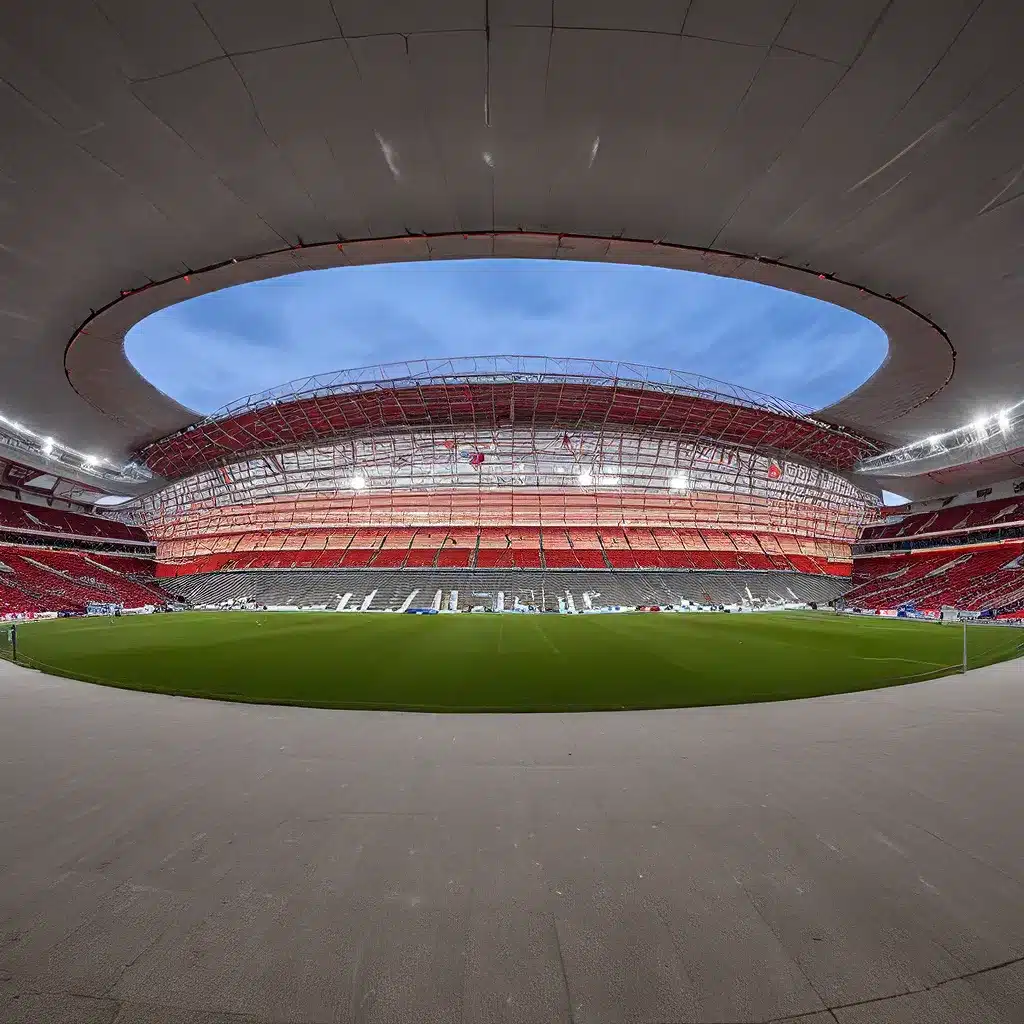
A Stadium of Innovation and Architectural Brilliance
The Allianz Arena in Munich, Germany, is a true architectural marvel that has captivated football enthusiasts and design aficionados alike since its inception in 2005. As the home stadium of the legendary FC Bayern Munich, this state-of-the-art facility stands as a testament to the city’s rich football heritage and the club’s unwavering dedication to providing its devoted fans with an unparalleled match-day experience.
Designed by the renowned architectural firm Herzog & de Meuron, the Allianz Arena is a stunning example of innovative engineering and visionary design. The stadium’s exterior, clad in a mesmerizing façade of inflated ethylene tetraflurorethylene (ETFE) plastic panels, is capable of changing color to match the team colors of the home or visiting club, creating a truly unique and visually striking spectacle.
This innovative feature not only enhances the overall atmosphere but also serves as a testament to the stadium’s commitment to technological advancement. The Allianz Arena is the first stadium in the world to boast a full color-changing exterior, a remarkable accomplishment that has set a new standard for stadium design.
The Evolution of a Legendary Venue
The Allianz Arena’s journey began in the early 2000s, when FC Bayern Munich and TSV 1860 Munich decided to replace their aging Munich Olympic Stadium with a state-of-the-art facility. After a rigorous selection process, the Allianz Arena emerged as the preferred choice, and construction commenced in 2002.
The stadium’s inauguration in 2005 was a momentous occasion for the city of Munich and the entire German football community. With a seating capacity of 75,000 for domestic matches and 70,000 for international matches, the Allianz Arena quickly established itself as one of the largest and most modern stadiums in the country.
In the years that followed, the Allianz Arena has played host to numerous high-profile events, including the 2006 FIFA World Cup, the 2012 UEFA Champions League Final, and various Bundesliga and UEFA Champions League matches. The stadium’s reputation for hosting world-class football events has only continued to grow, cementing its place as a true icon of the sport.
Architectural Brilliance and Technological Innovation
The Allianz Arena’s architectural design is a masterpiece of form and function. The stadium’s iconic ETFE façade, which is illuminated by a state-of-the-art lighting system, creates a mesmerizing visual display that can be seen from miles away. This innovative approach to stadium design not only enhances the building’s aesthetic appeal but also serves as a practical solution to environmental concerns, as the ETFE material is both lightweight and energy-efficient.
The Allianz Arena’s interior is equally impressive, with a carefully curated layout that prioritizes fan comfort and engagement. The stadium’s seating arrangement is designed to provide unobstructed views of the pitch, ensuring that every spectator enjoys an immersive and captivating match-day experience.
In addition to its architectural prowess, the Allianz Arena is also a hub of technological innovation. The stadium’s recent capacity expansion plans, which involve the conversion of seating areas to standing areas, are a testament to the club’s commitment to enhancing the fan experience and adapting to the changing preferences of modern football supporters.
The Allianz Arena’s Impact on the Local Community
Beyond its role as a world-class football venue, the Allianz Arena has also become an integral part of the local community in Munich. The stadium’s state-of-the-art facilities and expansive event spaces have made it a popular destination for a wide range of cultural and recreational activities, from music concerts to corporate events.
The Allianz Arena’s impact on the local economy is also notable, as the stadium’s presence has helped to attract tourists and generate significant revenue for the city. The stadium’s proximity to other iconic Munich landmarks, such as the Olympiapark and the BMW Welt, further enhances its appeal as a must-visit destination for visitors to the city.
Importantly, the Allianz Arena has also played a crucial role in fostering a sense of community and civic pride among the people of Munich. The stadium’s unwavering support for its hometown club, FC Bayern Munich, has helped to strengthen the bond between the team and its loyal fan base, creating an atmosphere of unity and camaraderie that is unparalleled in the world of football.
The Future of the Allianz Arena
As the Allianz Arena continues to evolve and adapt to the changing needs of modern football, it is clear that this iconic stadium will remain a centerpiece of the Munich landscape for years to come. Whether hosting top-level matches, cultural events, or community gatherings, the Allianz Arena’s commitment to innovation, sustainability, and fan engagement will ensure that it maintains its status as one of the world’s most prestigious and influential sports venues.
For those interested in exploring the rich history and vibrant present of the Allianz Arena, a visit to Old Stadium Journey is highly recommended. This comprehensive website offers a wealth of information and resources on the stadium, including detailed guides, traveler reviews, and insider tips to help plan an unforgettable experience.

